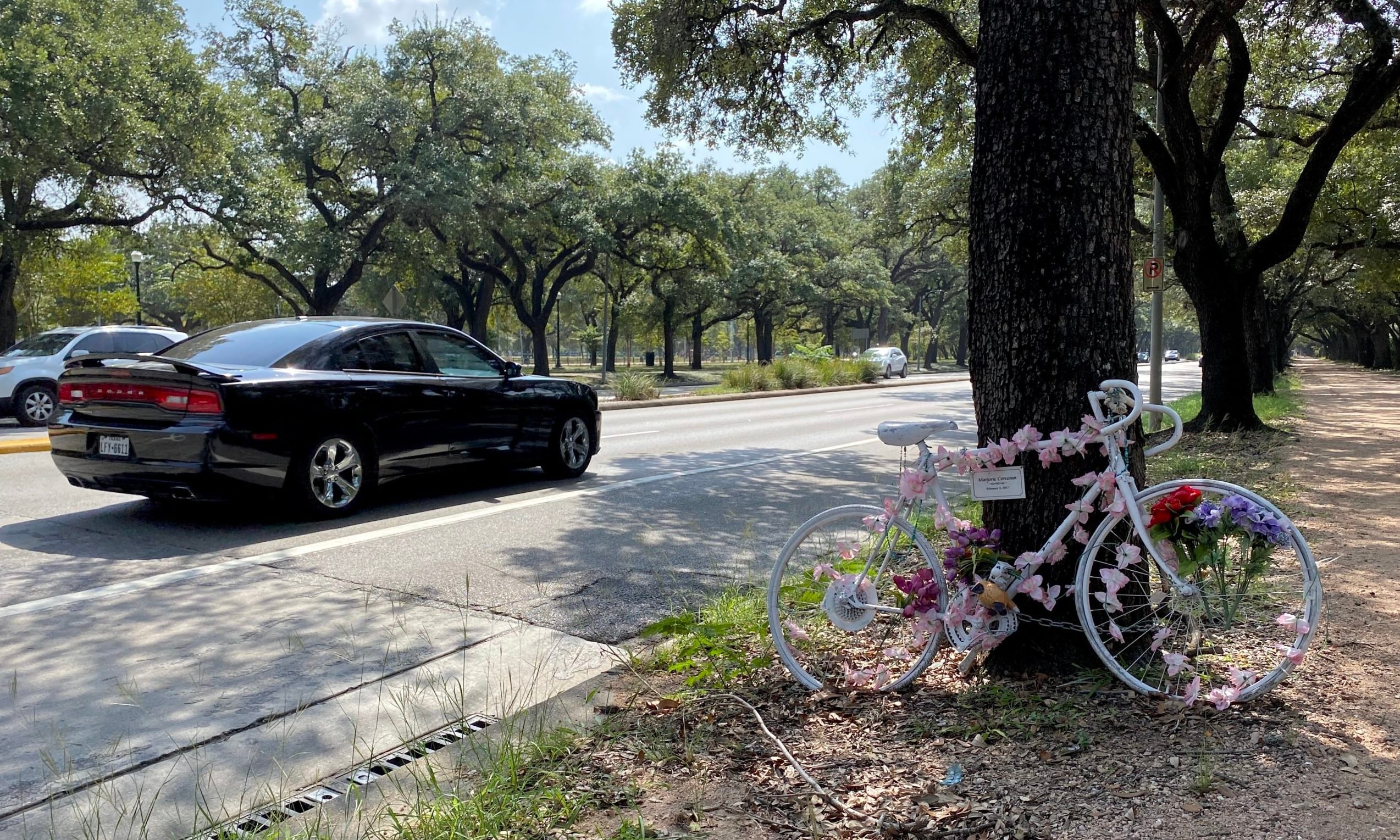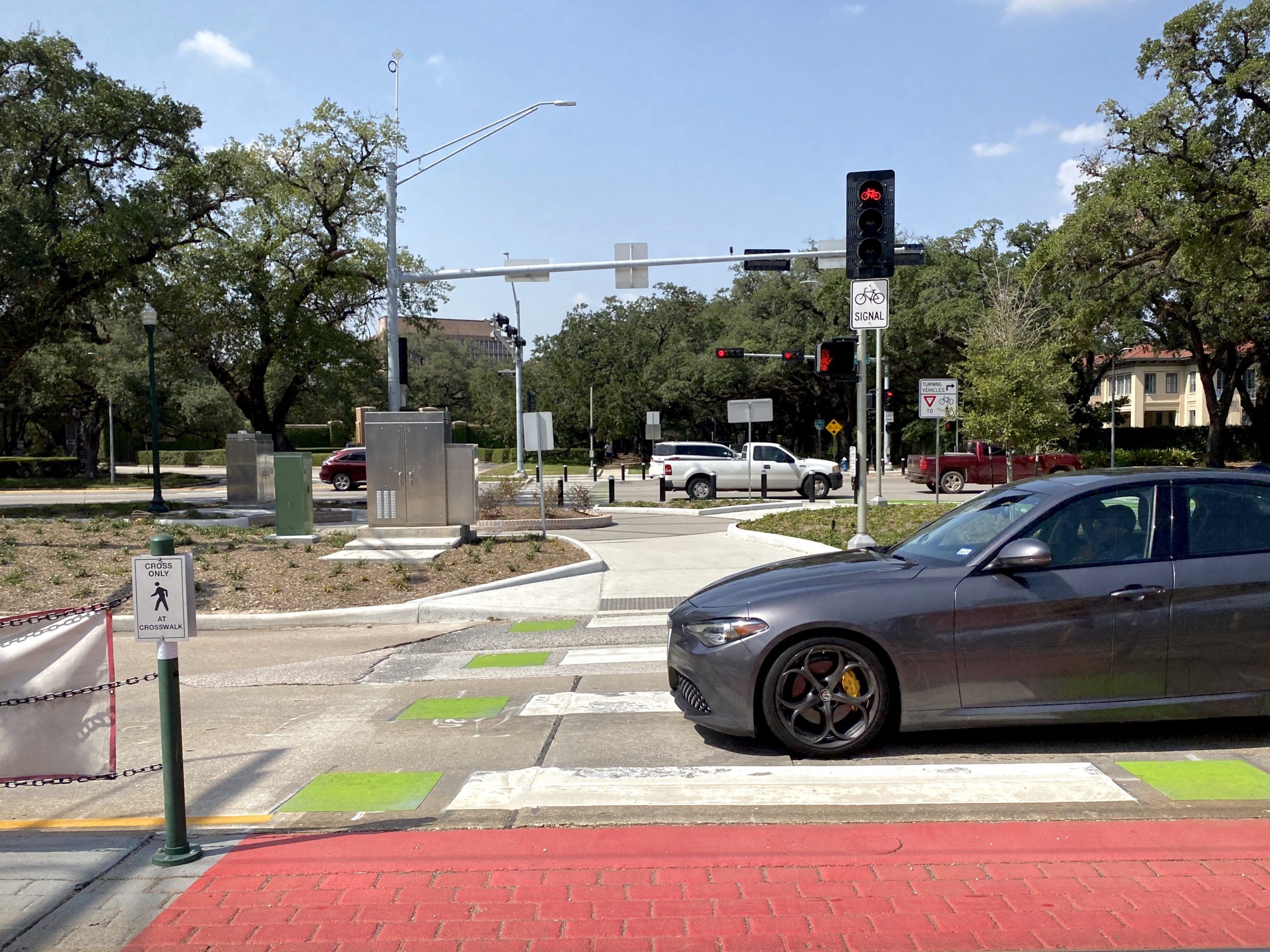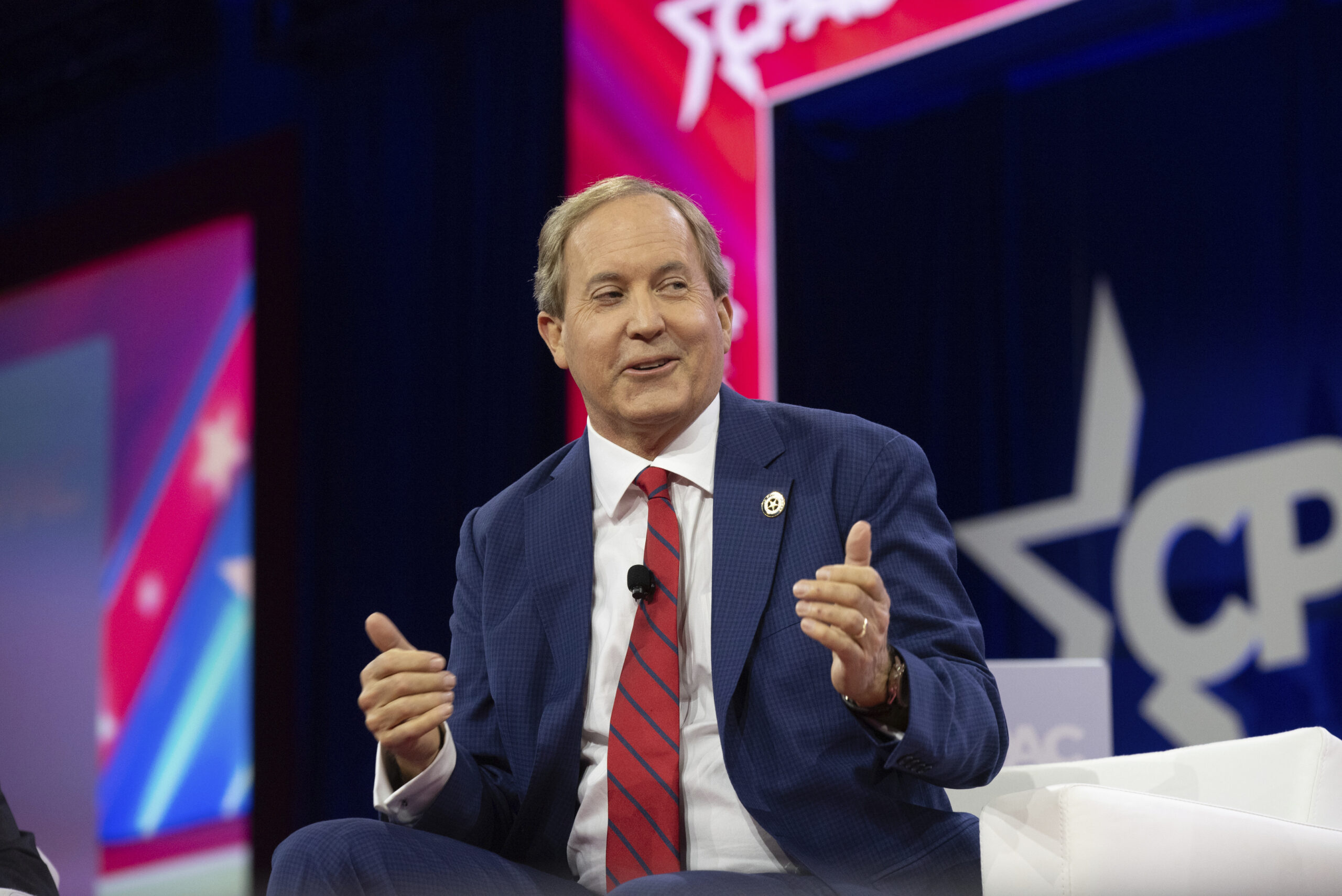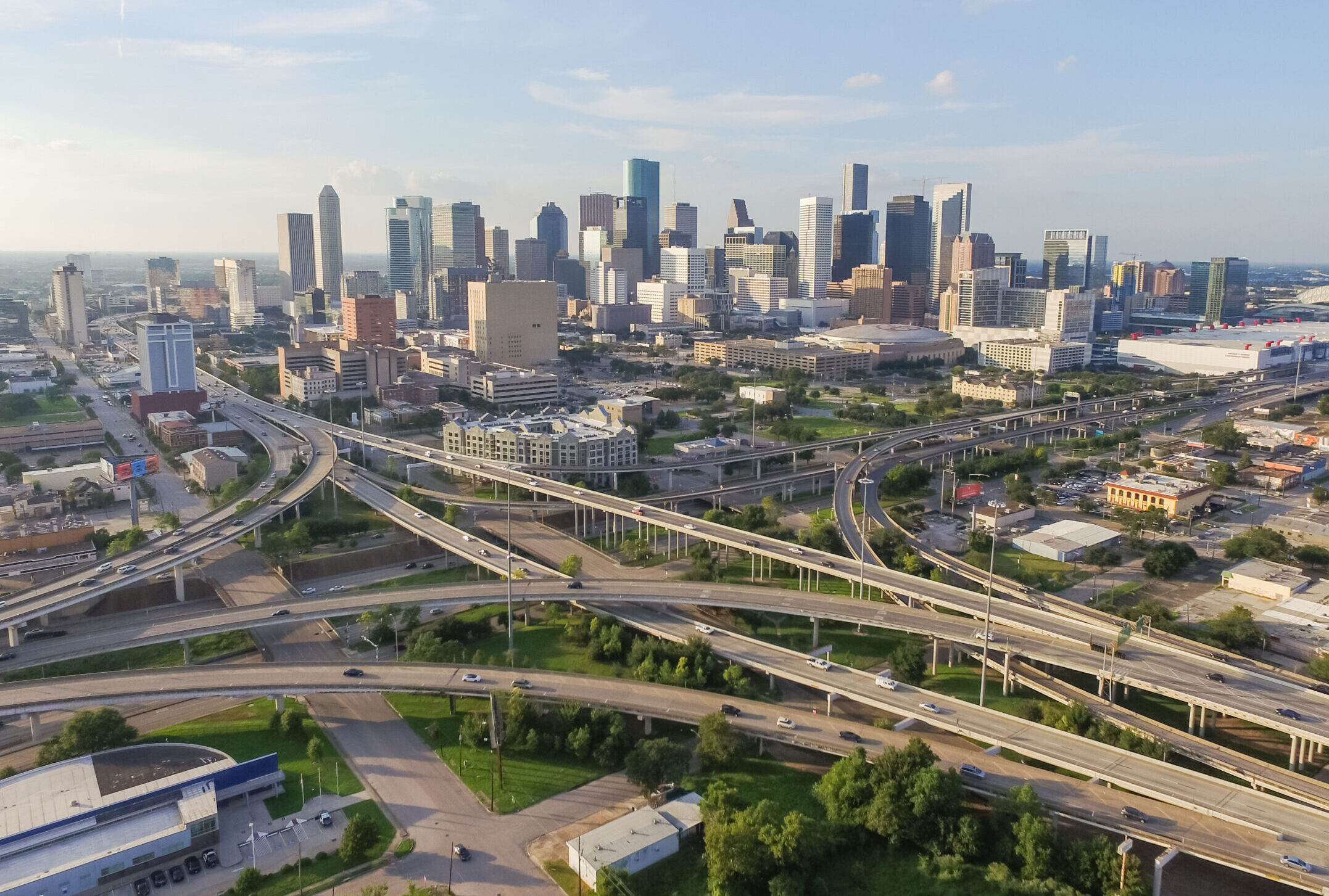
Achieving Vision Zero in Houston Isn’t Going To Happen One Intersection at a Time
Eliminating the thousands of injuries and deaths that happen on Houston’s streets will require a reckoning that the car-heavy city does not appear ready to make.
Above: The ghost bike memorial to Marjorie Corcoran and Sudipta Roy.
Marjorie Corcoran, a professor, was biking to work. Sudipta Roy, studying to be a nurse, had ridden to campus to see her husband. Both were struck and killed, in 2017 and 2018, in the intersection in front of Rice University where Main, Sunset and Fannin streets meet light rail tracks.
Three years later, this July, the City of Houston held a ribbon-cutting ceremony to celebrate the improvements it made, all within view of the ghost bike that leans against the trunk of a live oak as a memorial. The city had worked with neighbors, students, and leadership at Rice, METRO, the region’s transit authority, and Hermann Park on the improvements, but they were a long time coming. Carol Haddock, the city’s director of public works, admitted she learned how bad the intersection was in 1987, when she enrolled at Rice as a student. Even then, she said, “it was challenging and intimidating.”
Through a mask, Mayor Sylvester Turner congratulated and thanked everyone and said, “I am happy to fulfill a promise that this intersection would be safer.”
It is, somewhat, but thousands of other intersections remain just as challenging, intimidating, and dangerous in a city developed in gleeful postwar haste for the convenience of the most American of machines, the privately owned internal combustion engine. Though both Mayor Turner and Harris County commissioners have committed to Vision Zero, the catch-all for policies and plans to end serious transportation-related injuries and deaths by 2030, this incremental approach feels painfully slow to advocates like Mary Natoli, who was there that day to help cut the ribbon.
Behavior is contextual, any sociologist will tell you, and the entire context of the Sun Belt, with its stroads, its SUVS, and its politics of scarcity, is the issue.
Even after what she calls two “high-profile deaths,” it took the city three years to remove one turn lane and make modest changes, and even then “there was more willingness to take action and political will,” she says, “because it was too late.”
The ghost bikes, the murals, the rides of silence—they point backward. They grieve. Even the intersections that are improved become elegies in concrete. Leaders in the city that the Houston Chronicle described in 2018 as “the most deadly major metro area in the nation for drivers, passengers, and people in their path” remain far too myopic as they work to undo the problems they have inherited. The Chronicle reported at least 651 deaths last year. There will be hundreds more this year. It’s not just pedestrians and bicyclists who are dying. In Houston, 65 percent of the deaths and 80 percent of the serious injuries happen to drivers. Achieving Vision Zero is going to require a reckoning much, much larger than improving this or that intersection every few years.
That’s the argument at the heart of former Streetsblog editor Angie Schmitt’s new book, Right of Way: Race, Class, and the Silent Epidemic of Pedestrian Deaths in America (Island Press, 2020). In 2018 alone, across the country, 6,283 pedestrians were struck and killed, the highest number since the ’90s. All these deaths “are not just random acts of God or bad luck or the results of individual decision-making or laziness,” she writes, but “part of a systemic problem with systemic causes.”
In September, for example, a man in a wheelchair was trying to cross a poorly lit four-lane street in southeast Houston when he was struck and killed. At least the driver stopped to tell police he couldn’t see him. The driver wasn’t impaired, so police told reporters “there was no indication of any other issues.”
In fact, there’s every indication of many other issues. The pickup truck that killed the man was designed to be too big and engineered to move too fast for the human body to withstand an impact. It’s an issue that the man was expected to wheel more than half a mile out of his way to cross at a signal. It’s an issue that the sidewalks there are a mess. It’s an issue that the city doesn’t have enough money to repair the sidewalks residents have reported to be a mess. It’s an issue that crashes like these rarely lead to charges and are described later as “accidents.” Behavior is contextual, any sociologist will tell you, and the entire context of the Sun Belt, with its stroads, its SUVS, and its politics of scarcity, is the issue.
“What Houston in particular has not done well,” says Jonathan Brooks, director of policy and planning for LINK Houston, a nonprofit advocating for an equitable transportation network, “is changing the systems that result in the outcomes we have. This case-by-case, intersection-by-intersection approach can be good if you’re learning lessons you’re applying systemically, but fixing particular places has not changed things on a broader scale to improve safety for everyone.”
In 2018 and 2019, Brooks’ organization helped the city identify and conduct road safety audits on 12 of the most dangerous intersections in Houston. One was in Midtown, a few light rail stops north of Rice near a new Whole Foods, where there have been at least 60 crashes since 2010. Inspired by an aging freeway ramp that had been closed and needed to be rebuilt, city employees quickly developed a plan to make a range of safety improvements underneath it—raising crosswalks, rebuilding sidewalks, planting trees, and adding a shared trail for people to walk or bike.

Just months after another press conference where Mayor Turner announced his new safer streets initiative held near where another driver struck another man in a wheelchair (and the woman trying to help him cross the street), after he said, “Just because we made this intersection safer does not mean we need another horrific accident to take place before we improve other intersections,” he killed the plan.
At a city council meeting this spring, as residents who lived near the intersections showed up in masks to plead with him to let the improvements go forward, he said, “There is no consensus,” and that was that.
“This case-by-case, intersection-by-intersection approach can be good if you’re learning lessons you’re applying systemically, but fixing particular places has not changed things on a broader scale to improve safety for everyone.”
Lauren Grove, a transportation planner with the City of Houston, is working on the city’s Vision Zero plan, which should be released later this year. “We can design our streets so humans are behaving safely,” she says, “and there’s a level of awareness that’s triggered because we’ve just designed the street that way.”
But as she researched Vision Zero plans in other cities and made calls with planners and advocates, she has found one constant throughout: “It will not be successful without sustained political will.”
And it can’t come just from one city hall. The Texas Department of Transportation, which manages an awareness campaign called Walk Bike Safe Texas that tweets tips to 126 followers, is planning to spend about $7 billion to widen Interstate 45 throughout the center of Houston, from Midtown to Downtown to Near Northside to Independence Heights. About eight months after Governor Greg Abbott said Texas was in the thrall of “the last major buildout” of freeways and more than five years after Mayor Turner declared the need for a “paradigm shift” when it comes to transportation, TxDOT released a final environmental impact statement on the widening that runs 8,189 highly technical pages long.
TxDOT expects that the widening will be complete around 2030, when the city and county both intend for transportation-related deaths and serious injuries to have been eliminated. No one has explained how a project that TxDOT claims will lead to 100 percent more freeway vehicle miles traveled—more driving—and increased average speeds of up to 24 miles per hour—faster driving—is compatible with Vision Zero.
In her book, Schmitt cites a statistic that 94 percent of crashes “can be attributable to so-called human error.” I think it’s higher than that. Someone has died on the roads somewhere in Texas every day since 2000. TxDOT tweets from one hand using the hashtag #EndTheStreak, while with the other designing and engineering the roads Texans die on. I guess I think cognitive dissonance and political cowardice are human errors, too.
Read more from the Observer:
-
Lulu Seikaly Wants to Flip One of Texas’ Most Conservative Suburban Districts: In Collin County, the political newcomer is betting big on Asian American voters—and Republicans who are tired of Trump.
-
The Long Tail of Voter Suppression: As the growing number of Black and Latinx voters threaten the GOP’s stranglehold on power, attempts to limit safe voting options during the pandemic reveal a deeper sickness in Texas politics.
-
One Texas-Sized Loophole is Letting Lone Star Polluters Off the Hook: Texas facilities emitted 174 million pounds of pollution above permitted limits last year.


